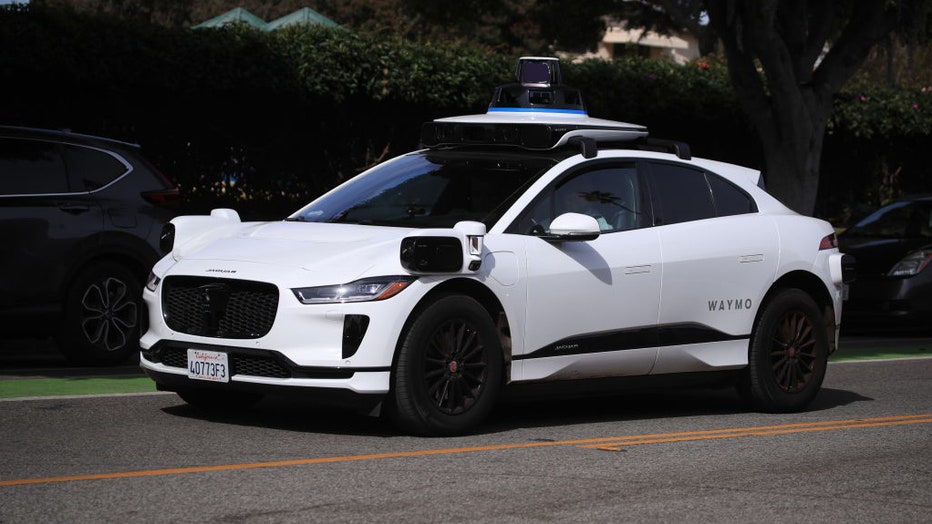Mayor Lurie allows Waymo to operate on San Francisco's Market Street

Waymo coming to Market Street
Waymo vehicles will soon be mapping and driving on Market Street in SF
SAN FRANCISCO - San Francisco Mayor Daniel Lurie on Thursday announced he will allow autonomous vehicles to operate on Market Street.
Lurie said the change will revitalize business along one of the city's main thoroughfares, but critics say that reintroducing private vehicles to a street where they had been banned is "chaotic" and "dangerous."
The privately-owned company will begin mapping the corridor in the coming weeks, with passenger service expected to launch this summer.

Passengers ride in an electric Jaguar I-Pace car outfitted with Waymo full self-driving technology in Santa Monica Tuesday, Feb. 21, 2023. (Allen J. Schaben / Los Angeles Times via Getty Images)
"Market Street runs through the heart of our city, and we're making sure it evolves with the times," Lurie said in a press release. "By welcoming Waymo, we're adding another safe and sustainable way to access shopping, theaters, hotels, and restaurants. This is about revitalizing downtown and making it easier for everyone, locals and visitors alike, to enjoy everything our city has to offer, whether they're taking Muni, a taxi or Waymo."
A press release from his office said allowing the self-driving cars to operate on Market St. will "advance San Francisco's longstanding legacy as a hub of transportation innovation, and support the evolution" of the traffic corridor.
Two steps back
The other side:
A coalition of mobility advocates denounced the move as a step backward. Kid Safe SF, the San Francisco Bicycle Coalition, San Francisco Transit Riders and Walk San Francisco released a joint statement in response to the news.
"Mayor Lurie's unilateral decision to give Waymo free reign on Market Street is dangerous, undemocratic and inequitable," Dylan Fabris, the community and policy manager for San Francisco Transit Riders said in a statement. "Allowing Waymo exclusive access to Market Street essentially creates a nearly two-mile-long city-sanctioned monopoly for the Google-owned tech company — all while the city is cutting Muni service on the same corridor."
The San Francisco Municipal Transit Authority is facing a projected $322 million budget shortfall beginning in July 2026, as pandemic relief funding expires. The organization earlier this year announced a plan to cut service by 2%, which will save about $7 million.
Christopher White, the Executive Director of the San Francisco Bicycle Coalition said that if Lurie wants Market Street to reclaim its "rightful place as a commercial and cultural destination," the city should prioritize safe, affordable ways of travel such as walking, biking and transit.
District 9 Supervisor Jackie Fielder, in a social media post on Thursday, sided with Lurie's critics.
"Waymo should be taxed to fund public transit," Fielder wrote.
Uber, Lyft and other privately-owned rideshares were considered for inclusion but ultimately rejected because "it is impossible to distinguish between a rideshare vehicle and a private vehicle."
Car-free Market
The backstory:
Private vehicles have since 2020 been banned on Market Street between Van Ness Avenue and Steuart Street. The road has only been accessible to Buses, streetcars, taxis, bicycles, scooters and other small mobility devices since then. Muni travel times have improved up to 14% as a result, and traffic collisions have been reduced by 40%.
Muni last year received the highest customer satisfaction rating in over 20 years, due in large part to more reliable and efficient bus service.
Ridership on Market Street bus lines has recovered at a faster rate than for Muni as a whole, with lines that serve Market Street seeing a 79% recovery of pre-pandemic ridership.
Banning private traffic was part of the Better Market Street project, an improvement project that was planned for over a decade, with the goal of reimagining the road as a transit, pedestrian and bicycle corridor. That project was scaled back as a result of the Coronavirus pandemic, and only the first of a planned three phases was implemented.
Lurie's announcement comes just weeks after he and other city leaders authorized Waymo to map roads to San Francisco International Airport.
Waymo's leadership team has been "thrilled" by Lurie's embrace of its driverless vehicles.
"We're honored that Mayor Lurie has invited us to serve as a mobility option on San Francisco's historic Market Street," Waymo co-CEO Tekedra Mawakana said in a statement.
Sutter Station Tavern proudly says it has been here on Market Street since 1969. Barbara Alessi said she thinks Waymo on Market will improve her bottom line.
"Absolutely true," said Alessi. "Because a lot of customers who come here, they want to take Waymo to get here. They can't do it on Market. They have to take Montgomery, Sutter which is a walk and that would be absolutely amazing and it does bring more business here."
AVs navigating on Market St.
Billy Riggs is the director of the Autonomous Vehicles and the City Initiative and teaches at the University of San Francisco. He said Waymos should be able to map Market Street quickly and begin ferrying passengers.
"It's a environment that, it can be complicated for a human driver," said Riggs. "It will be equally challenging for a robotic driver. But, it's nothing a robotic driver can't handle, just like it's nothing that a human driver can't handle."
Riders we spoke with also said they think the autonomous vehicles should have no trouble navigating a route with cars, trains, buses and bikes.
"I think Market Street…it should be fine," said Himanshu Borole. "I have seen Waymos navigate themselves pretty well. So, it should be fine."
The Source: Mayor Daniel Lurie's office, Dylan Fabris, San Francisco Transit Riders, Christopher White, San Francisco Bicycle Coalition, Jackie Fielder, San Francisco Government
Featured
Waymo among vehicles hit in deadly 7-car crash in San Francisco
At least one person has died after a car crash involving seven vehicles collided in San Francisco Sunday evening.


